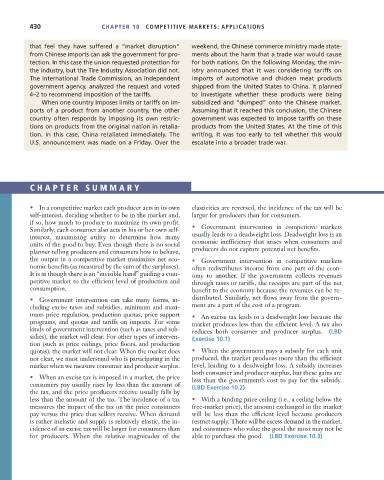Page 456 - Microeconomics, Fourth Edition
P. 456
c10competitive markets applications.qxd 7/15/10 4:58 PM Page 430
430 CHAPTER 10 COMPETITIVE MARKETS: APPLICATIONS
that feel they have suffered a “market disruption” weekend, the Chinese commerce ministry made state-
from Chinese imports can ask the government for pro- ments about the harm that a trade war would cause
tection. In this case the union requested protection for for both nations. On the following Monday, the min-
the industry, but the Tire Industry Association did not. istry announced that it was considering tariffs on
The International Trade Commission, an independent imports of automotive and chicken meat products
government agency, analyzed the request and voted shipped from the United States to China. It planned
4–2 to recommend imposition of the tariffs. to investigate whether these products were being
When one country imposes limits or tariffs on im- subsidized and “dumped” onto the Chinese market.
ports of a product from another country, the other Assuming that it reached this conclusion, the Chinese
country often responds by imposing its own restric- government was expected to impose tariffs on these
tions on products from the original nation in retalia- products from the United States. At the time of this
tion. In this case, China retaliated immediately. The writing, it was too early to tell whether this would
U.S. announcement was made on a Friday. Over the escalate into a broader trade war.
CHAPTER SUMMAR Y
• In a competitive market each producer acts in its own elasticities are reversed, the incidence of the tax will be
self-interest, deciding whether to be in the market and, larger for producers than for consumers.
if so, how much to produce to maximize its own profit.
Similarly, each consumer also acts in his or her own self- • Government intervention in competitive markets
interest, maximizing utility to determine how many usually leads to a deadweight loss. Deadweight loss is an
units of the good to buy. Even though there is no social economic inefficiency that arises when consumers and
planner telling producers and consumers how to behave, producers do not capture potential net benefits.
the output in a competitive market maximizes net eco- • Government intervention in competitive markets
nomic benefits (as measured by the sum of the surpluses). often redistributes income from one part of the econ-
It is as though there is an “invisible hand” guiding a com- omy to another. If the government collects revenues
petitive market to the efficient level of production and through taxes or tariffs, the receipts are part of the net
consumption. benefit to the economy because the revenues can be re-
• Government intervention can take many forms, in- distributed. Similarly, net flows away from the govern-
cluding excise taxes and subsidies, minimum and maxi- ment are a part of the cost of a program.
mum price regulation, production quotas, price support • An excise tax leads to a deadweight loss because the
programs, and quotas and tariffs on imports. For some market produces less than the efficient level. A tax also
kinds of government intervention (such as taxes and sub- reduces both consumer and producer surplus. (LBD
sidies), the market will clear. For other types of interven- Exercise 10.1)
tion (such as price ceilings, price floors, and production
quotas), the market will not clear. When the market does • When the government pays a subsidy for each unit
not clear, we must understand who is participating in the produced, the market produces more than the efficient
market when we measure consumer and producer surplus. level, leading to a deadweight loss. A subsidy increases
both consumer and producer surplus, but these gains are
• When an excise tax is imposed in a market, the price less than the government’s cost to pay for the subsidy.
consumers pay usually rises by less than the amount of (LBD Exercise 10.2)
the tax, and the price producers receive usually falls by
less than the amount of the tax. The incidence of a tax • With a binding price ceiling (i.e., a ceiling below the
measures the impact of the tax on the price consumers free-market price), the amount exchanged in the market
pay versus the price that sellers receive. When demand will be less than the efficient level because producers
is rather inelastic and supply is relatively elastic, the in- restrict supply. There will be excess demand in the market,
cidence of an excise tax will be larger for consumers than and consumers who value the good the most may not be
for producers. When the relative magnitudes of the able to purchase the good. (LBD Exercise 10.3)

